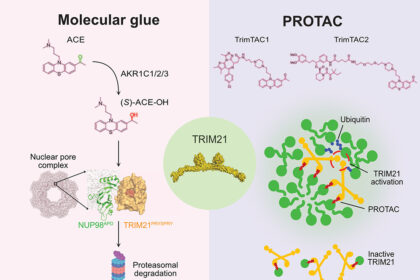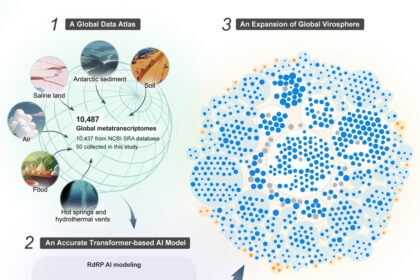Imagine walking into a lab and being hit with a smell that you just can’t shake off. It clings to everything, even the paper on which it was blotted. This isn’t just any smell—it’s a completely new scent, created by researcher Alex Wiltschko and his team at a company called Osmo in Cambridge, Massachusetts. To Wiltschko, this scent brought back memories of summertime in Texas, where watermelon slices reveal that boundary where the juicy red flesh turns into a pale white rind. The surprising part? The molecule responsible for this smell was unlike anything anyone had seen before. You’d never guess that this particular structure would produce such a scent.
The world of smell is a tricky one. Unlike colors, where red is red and blue is blue, the chemical structure of a molecule tells you almost nothing about its smell. Two chemicals that look similar might smell completely different, and two that are wildly different in structure might smell almost identical. And when it comes to familiar scents like coffee, cheese, or tomatoes, you’re not just smelling one thing—these are complex mixtures of many different molecules working together.
Understanding how these smells work, and how they relate to each other, is a massive challenge.
Researcher daily
Unlike vision, where you can map colors on a spectrum, or sound, which has clear frequencies, smell is more mysterious. How would you even begin to categorize something like the smell of frost compared to the scent of a sauna? This challenge is one that scientists like Joel Mainland at the Monell Chemical Senses Center in Philadelphia are trying to tackle.
Our noses are incredible, evolved tools for decoding smells. Humans have about 400 different types of receptor cells dedicated to smell, each one responding to different chemicals1. But exactly how these signals combine to form what we recognize as a particular smell is still mostly a mystery. Scientists have only recently started to get a clearer picture, thanks to advancements in technology like artificial intelligence (AI) and data analytics. Cracking the code of smell could help us understand not just how animals use this sense to find food or mates, but also how it influences things like memory, emotions, and even appetite.
Wiltschko’s team, which was once part of Google’s AI research division, is making headway in this area2. They’ve developed an AI model that tries to predict how certain molecules will smell. The model was trained using descriptions from fragrance catalogues, with terms like “floral” or “smoky.” Then, they compared the AI’s predictions to human noses.
While humans have a hard time agreeing on how something smells, the AI managed to predict scents pretty well, often better than the average person.
Alex Wiltschko
The AI even managed to create a map of smells, grouping them into categories like “meaty” or “woody.” But the real challenge is predicting how mixtures of smells will come together. This is something the team is working on now. They hope that someday the AI might even be able to design new scents, perhaps creating safer or more sustainable fragrances.
But AI can’t do everything on its own. Human expertise is still crucial, especially when it comes to innovation in fields like flavor and fragrance creation. The way our brains process smell is also incredibly complex. The nose has millions of olfactory neurons, each with a unique type of receptor, and these receptors respond to a huge range of chemicals. Understanding how these receptors work, and how they translate a chemical structure into a smell, is one of the big puzzles researchers are trying to solve.
Some scientists are using machine learning to speed up this process, predicting which molecules will bind to certain receptors and what smells they might produce. For example, they’ve identified molecules that smell like orange blossoms or honey just by using AI models.
Even with these advancements, there’s still a lot we don’t know about how smells are processed in the brain, particularly in regions like the olfactory cortex. Some researchers hope that one day we might be able to simulate smells directly in the brain, without needing the actual odorant—essentially creating smells out of thin air by manipulating the brain’s signals.
Smell is also big business. Companies are working on “electronic noses” that could diagnose diseases, detect harmful chemicals, or improve food safety. While natural noses, like those of dogs, are still the best at detecting certain scents, these electronic noses are getting better all the time.
Note
The market for electronic nose technology is projected to reach $34.1 billion by 2025, growing at a compound annual growth rate (CAGR) of 9.8%
Researchers are even blending animal and digital detection methods. For example, one team developed a device that records signals from a mouse’s brain as it smells different compounds3. This allows them to identify smells with the precision of the mouse’s natural ability, but without needing to train the animal.
The world of smell is more complex and fascinating than we might think. Scientists are making exciting strides in understanding and even digitizing this elusive sense, and the implications could be huge—from creating new fragrances to developing better tools for detecting diseases. Smell might just be having its moment, and we’re only beginning to scratch the surface of what’s possible.
1 Rinaldi, A. (2007) “The scent of life. The exquisite complexity of the sense of smell in animals and humans: The exquisite complexity of the sense of smell in animals and humans,” EMBO reports, 8(7), pp. 629–633. doi: 10.1038/sj.embor.7401029.
2 Mullin, E. (2023) “This Startup Is Using AI to Unearth New Smells,” Wired, 24 January. Available at: https://www.wired.com/story/this-startup-is-using-ai-to-unearth-new-smells/ (Accessed: September 5, 2024).
3 Throesch, B. T. et al. (2024) “Functional sensory circuits built from neurons of two species,” Cell, 187(9), pp. 2143-2157.e15. doi: 10.1016/j.cell.2024.03.042.











